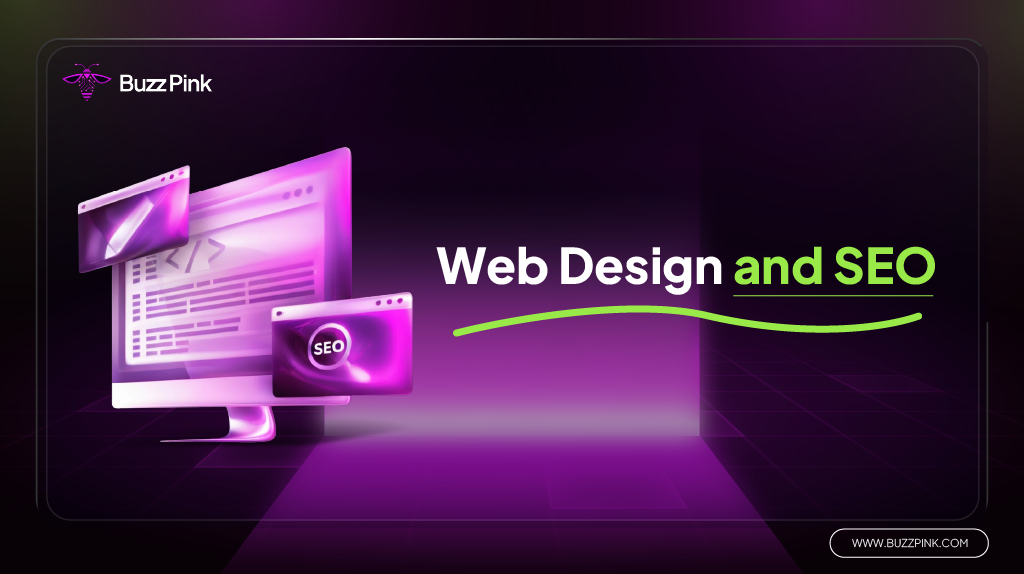Web Design and SEO: Reasons Your Website Needs Both
Have you ever visited a website that looked great but was difficult to find on Google? Alternatively, have you discovered a website that appears at the top of Google but is poorly designed and confusing? That is why web design and SEO must work hand in hand.
Web design refers to the appearance and structure of a website, whereas SEO (Search Engine Optimization) refers to how the website can be easily found in search engines such as Google. Thus, web design and SEO must collaborate to make a website easily discoverable and provide a pleasant experience for visitors.
What Are Web Design and SEO?
 Everything you see when you open a website, including colors, text, images, buttons, and how you navigate between pages, is referred to as web design. Web design should make it easier for visitors to understand the page’s content. Visitors may quickly leave a website that is confusing, slow, or difficult to read. As a result, the design should prioritize user experience.
Everything you see when you open a website, including colors, text, images, buttons, and how you navigate between pages, is referred to as web design. Web design should make it easier for visitors to understand the page’s content. Visitors may quickly leave a website that is confusing, slow, or difficult to read. As a result, the design should prioritize user experience.
SEO, on the other hand, refers to the process of increasing website visibility in Google search results. To help Google understand your website’s content, SEO organizes the content, page structure, and loading speed and uses specific keywords. If you successfully implement SEO, your website may appear on Google’s first page when people search for relevant topics. A blend of web design and SEO will turn your website appealing and effortless to find.
Why Are Web Design and SEO Important?
If your website is well-designed but does not appear on Google’s first page, people will not know it exists. Similar to when you print a lot of flyers but never distribute them to anyone. Without SEO, a website is merely an empty display rack. On the other hand, people will leave your site if it appears in Google’s search results but is difficult to read and use. As a result, it’s highly essential to integrate web design and SEO.
By combining the two, you can attract visitors through Google’s search without having to pay for ads. People who are truly interested will take the time to explore your website. This increases the chances of registering, subscribing, or even purchasing. Combining web design and SEO can provide benefits.
Increases Organic Traffic
 Organic traffic refers to visitors who find their way to your website via Google search results rather than seeing an ad. This is critical because 90% of people only click on results on the first page of Google. In fact, the top search result typically receives more than 25% of clicks. This means that if your website is in the top rankings, the chances of people visiting it are significantly higher.
Organic traffic refers to visitors who find their way to your website via Google search results rather than seeing an ad. This is critical because 90% of people only click on results on the first page of Google. In fact, the top search result typically receives more than 25% of clicks. This means that if your website is in the top rankings, the chances of people visiting it are significantly higher.
SEO works by making your website’s pages more relevant and high-quality, allowing Google to rank them higher. With proper SEO, you can compete with larger websites without spending money on advertising. This is a low-cost, long-term strategy that can deliver consistent results as long as the content is relevant.
Attracts High-Intent Traffic
People who use Google typically have a specific intent. If your website appears and provides the information they are looking for, they will click and visit it. This is in contrast to visitors who come from advertisements or social media, who frequently come for entertainment.
When you attract people with high intent, you not only get visitors, but also people who are more likely to buy or listen to your advice. This is referred to as high-intent traffic, and its value is significantly higher than regular traffic. And that is why SEO is so vital for pulling in quality visitors.
Increases User Experience
User experience (UX) refers to how visitors feel while using your website. People will feel more at ease and stay longer if it is clean, simple to use, has functional buttons, and loads quickly. According to research, every 1-second increase in website speed can boost sales significantly.
Google prioritizes user experience when determining search rankings. So, in addition to good content, your website should be user-friendly. Poor design, confusing navigation, or slow loading can all drive visitors away, which is a bad sign for Google. Thus, user experience is an important aspect of SEO.
How to Optimize Web Design and SEO
 Web design and SEO are two critical components that work together to make your website not only visually appealing but also easily searchable online. People will leave your website quickly if it is not well-designed. Without SEO, they may never be aware of your website’s existence. Combining the two will make your website look professional and user-friendly and more likely to appear on Google’s first page.
Web design and SEO are two critical components that work together to make your website not only visually appealing but also easily searchable online. People will leave your website quickly if it is not well-designed. Without SEO, they may never be aware of your website’s existence. Combining the two will make your website look professional and user-friendly and more likely to appear on Google’s first page.
If you want your website to be successful, whether it’s for your business, portfolio, or just a personal blog, you should prioritize these two aspects from the start. Web design keeps visitors engaged, whereas SEO draws them in. The combination will help you gain trust, increase traffic, and encourage visitors to take action, such as purchasing or registering.
Code
When you create a website, all of the visual elements you see, such as colors, images, and buttons, are coded using HTML and CSS. Coding is important because it affects how your website appears to visitors and Google’s search. For example, if you’re still using outdated technology like Flash, Google will have a difficult time reading your site. As a result, your website will have a harder time ranking on Google’s first page.
This suggests that neat and light coding is easier for Google to read. Avoid using complex codes or inaccessible formats that search engines will struggle to find. If the code is neat and follows the standards, the load time will be reduced, which Google will consider a plus.
Mobile Friendliness
Nowadays, most people browse on their smartphones rather than computers. In fact, mobile users make up for greater than 50% of all website traffic. As a result, if your website design is not optimized for small screens, visitors will leave immediately. Furthermore, this results in high bounce rates, which affects Google’s ranking.
Its mobile-friendly design makes it suitable for smartphones, tablets, and even desktops. The text is easy to read, the buttons are thumb-friendly, and the navigation is simple to understand. Aside from making things easier for visitors, Google can give you a high score for responsiveness. So, mobile-friendliness isn’t just about comfort, it’s also necessary to improve your rank.
Read More: Local SEO vs. Global SEO: Understanding the Differences for Your Business
Readability
Readability refers to how easy it is for visitors to read your website. It’s not just about the writing, but also how you organize each paragraph, the titles, and even the font you use. If the sentences are too long and the font is too small, people will struggle to understand the information you are delivering through the articles. They will flee, and this will influence your website’s ranking.
To improve readability, ensure that there are enough paragraphs, use simple or easy words, and include headings so that visitors understand the main topic of the article. To avoid reader fatigue, the design must also include white space. If your website is enjoyable to read, visitors will most likely stay longer, increasing your SEO rankings.
Quality content
Your website’s soul is made up of qualified content. Google will always prioritize the best search results, so they will choose content that can help visitors solve their problems. If your content is poorly written and created solely to appear active, Google will consider your website irrelevant and will not improve its ranking.
Great content consists of E-E-A-T, which stands for experience, expertise, authority, and trustworthiness. This means you must have prior experience, understand the subject matter, be trustworthy, and demonstrate your expertise. Write helpful content for visitors, provide solutions to their concerns, and direct them to explore the website further.
Common Mistakes in Web Design and SEO
Many people focus on web design when developing a website, but they overlook the technical aspects, which are critical for SEO. These mistakes are frequently overlooked, despite the fact that they can have an impact on your Google rankings. The best strategy is to strike a balance between creating high-quality content and polishing the web design to ensure it is neat.
It is critical for us to identify common mistakes in web design and SEO. Acknowledging the errors allows you to take preventative measures from the start. Consider web design and SEO to be two sides of the same coin, which must be balanced.
Neglecting Mobile Optimization
One of the most common mistakes is failing to consider mobile web design. The truth is that most people browse using their Visitors will leave if your website is only neat on desktop but messy and laggy on mobile.
Visitors will be frustrated if your website is not mobile-friendly. They will have difficulty reading the contents because they will have to go back and forth between pages or will keep clicking on the wrong page due to the button’s small size. All of these factors have an impact on the user experience and are likely to deter them from returning. As a result, a responsive web design that adapts to the user’s device is essential.
Slow Page Load Times
A page that buffers will not entice people to stay. In reference to one study, if a page waits longer than 3 seconds to load, people will automatically skip it. Latency issues are frequently caused by large images, messy code, or crowded servers. Aside from driving away potential customers, Google will take note of your site’s inability to keep visitors.
If your website is slow, you not only lose potential readers and buyers, but also the chance to appear on Google’s first page. A fast website makes a good impression by appearing professional and trustworthy, making visitors feel comfortable exploring it. As a result, you must monitor and maintain your website on a regular basis.
Ignoring On-Page SEO Elements
On-page SEO elements such as the page title, meta description, headings, and keywords are required for Google to identify each topic on your website. Many people overlook these minor details, despite the fact that they serve as the foundation for Google’s indicators that determine whether or not your page is relevant.
If these are left empty or not optimized, Google may misinterpret your page or even ignore it. Take the example of a meta description; if it is not appealing and informative, people will not click. This implies that you must not devalue these aspects when establishing a website.
Poor Site Structure and Navigation
A cluttered website structure confuses visitors and makes them easily lost. If someone can’t find what they’re looking for in a few seconds, they’ll probably leave right away. This also makes it difficult for Google to understand the links between pages, which can have a negative impact on SEO.
A good website should have a clear structure, much like a store with well-organized shelves by category. Navigation should also be simple, such as through easily accessible menus and page links. The easier it is for people to move from one page to the next, the longer they will stay on your website, which is a good sign for SEO.
Lack of Quality Content
Random or copied-and-pasted content will not compete on Google. Search engines such as Google are becoming more intelligent and only want to display truly useful and original content. Your ranking will most likely suffer if your content is bland, incomplete, or simply promotional, with no informational value.
Read More: How to Integrate SEO and User Experience for Better Website Performance
Quality content responds to user questions, provides solutions, or offers trustworthy information. Google even uses E-E-A-T guidelines to assess the trustworthiness of content. So, create in-depth, engaging, and relevant content for your visitors.
Overlooking Internal Linking
Internal linking is when one page of your website hyperlinks to another on the same site. Many people overlook this, despite its significant benefits. Internal links help visitors find additional related information, allowing them to stay on your website longer and gain a better understanding of the topics you’re discussing.
Furthermore, internal linking also helps Google assess your website’s structure. By connecting pages, you tell Google which ones are important. This can help those pages get indexed faster and appear higher in search results.
Ignoring Technical SEO
Many people believe that SEO is all about content and keywords, but there is a hidden aspect known as technical SEO that is equally Server speed, security (HTTPS), URL structure, sitemaps, and Google-readability are all factors to consider. If this aspect is overlooked, search engines may fail to detect your website.
For example, if Google is unable to crawl your page due to errors in the code or website structure, it will not appear in search results, regardless of the quality of the content. Technical SEO is similar to a house’s foundation. If the foundation is fractured, the entire structure may crumble. As a result, make sure that the technical aspects of your website are taken care of from the beginning.
Looking for a Web Design and SEO Agency?
If you feel like all of the above is too complicated to do yourself, that’s understandable. Building and optimizing a website requires specialized knowledge and experience. This is where an agency like Buzz Pink comes in. Buzz Pink has extensive experience creating websites that are not only visually appealing but also SEO and user-friendly. So you don’t have to worry about design, SEO, speed, or technical structure because our expert team can handle it all.
Buzz Pink is also recognized for its strategic and creative approach. We don’t create websites at random, but rather carefully plan them based on research and business requirements. We can help your website rank on Google’s first page and increase sales by combining attractive design, optimal technical performance, and targeted SEO strategies. So, if you need a partner to create a cool and effective website, Buzz Pink is the right choice.
Conclusion
For a website to succeed, web design and SEO must work together. A visually appealing design will keep visitors interested, while proper SEO will help them find your website on Google.
The combination of the two will boost traffic, build trust, and, ultimately, increase profits. To accomplish all of this, you must avoid common mistakes such as poor mobile design, low-quality content, and a confusing website structure.
Kamila Putri is a content strategist and digital marketing expert who helps brands craft messages that resonate and drive results. With a strong foundation in SEO, brand voice, and data-driven strategy, she has produced content that performs, whether it's optimized web copy, lead-generating campaigns, or conversion-focused messaging. At Buzz Pink, she applies this expertise to help clients grow through smart, search-focused digital strategies that engage, inform, and convert.


